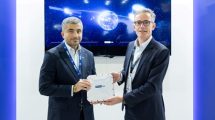 Launch services provider Spaceflight has announced that it will be launching 13 customer payloads, including four microsatellites and nine CubeSats to Sun Synchronous orbit (SSO) aboard the SpaceX Transporter-3 mission, scheduled to launch no earlier than January 2022 from Cape Canaveral.
Launch services provider Spaceflight has announced that it will be launching 13 customer payloads, including four microsatellites and nine CubeSats to Sun Synchronous orbit (SSO) aboard the SpaceX Transporter-3 mission, scheduled to launch no earlier than January 2022 from Cape Canaveral.
On this mission, which the company has dubbed ‘SXRS-6,’ Spaceflight will deploy customer spacecraft to two distinct orbits for the first time using its chemical propulsion orbital transfer vehicle (OTV), Sherpa-LTC1. Capping a momentous year for Spaceflight, this mission will be the third debut of a new class of Sherpa vehicles within 12 months.
Once Sherpa-LTC1 deploys from the Falcon 9 at 525 kilometres, the OTV will begin its primary mission, deploying nine customer smallsat payloads. After commissioning and checking out all systems, which is expected to take about a month, Sherpa-LTC1 will fire up and manoeuvre to a lower altitude for the secondary mission, deployment at a customer-specified orbit. After dropping to 500 kilometres, the OTV will deploy the remaining four CubeSat payloads. The OTV will then begin its final mission phase, on-orbit testing, and automated manoeuvring.
Spaceflight is managing this launch for eight organisations, including returning customers Capella Space, Umbra Space, Lynk Global, Inc., Kleos Space, and NASA. SXRS-6 will also include several first-time customers, including Czech Aerospace Research Centre in partnership with Spacemanic, Space Products and Innovation (SPiN), and Portland State Aerospace Society.
Ryan Olcott, Mission Director for Spaceflight’s SXRS-6 mission, said: “Each of our Sherpa launches this year has incrementally brought vital learnings that have prepared us to launch Sherpa-LTC1 to execute our first in-space multi-destination mission. This milestone mission validates our ability to provide customers with more customized launch options to achieve their mission objectives and get them to their final destination, even when there are no launches that initially meet their specific mission needs. Using our propulsive Sherpa OTVs for last-kilometre delivery is a ground-breaking capability for smallsats.”
Featuring a high thrust, bi-propellant, green propulsion subsystem from Benchmark Space Systems, Sherpa-LTC provides a low-cost, rapid orbital transfer for many sizes of small spacecraft and is also capable of hosting payloads on orbit.
Grant Bonin, SVP of business development at Spaceflight, added: “This mission will debut the third model of our Sherpa-NG product line in just 12 months, delivering on the promise of modularity by expanding the range of launches we offer. Manoeuvres in LEO are just the beginning. These capabilities and services will play a crucial role in accessing other orbits beyond LEO and developing in-space transportation and various mission services.”
Spaceflight recently announced a fourth iteration of the Sherpa-NG programme — Sherpa-ES, a bipropellant, high delta-V OTV, which the company plans to debut no earlier than Q4 2022 on Intuitive Machines’ IM-2 South Pole Mission. Sherpa-ES will enable Spaceflight to execute rideshare deployments in trans-lunar orbit, low-lunar orbit, and beyond. The GEO Pathfinder rideshare mission will utilize a creative trajectory to slingshot around the Moon and into a geosynchronous equatorial orbit (GEO). This continues Spaceflight’s history of industry firsts, including the first fully dedicated SSOA rideshare mission with 64 smallsats on board, the first-ever rideshare mission to GTO with a lunar lander, and the launch of the first-ever electric propulsion OTV.












Add Comment